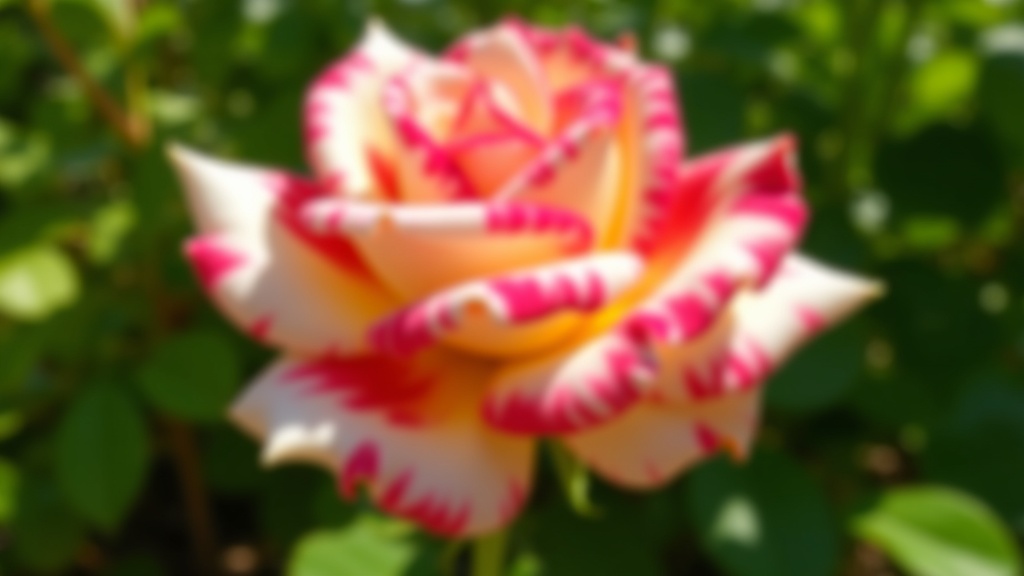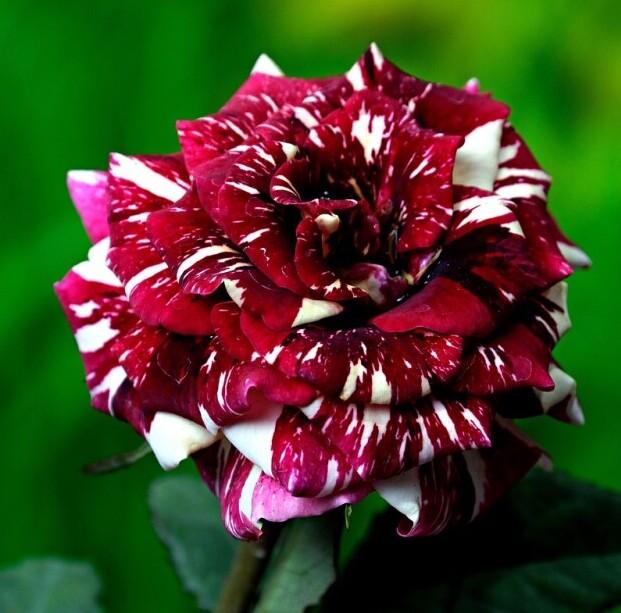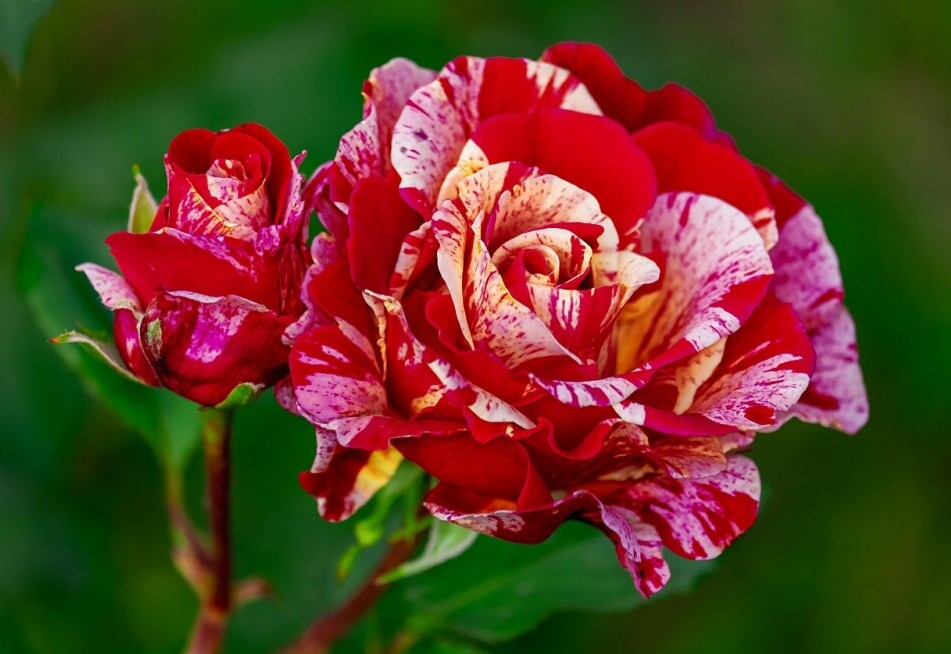Striped roses are real showstoppers in the world of gardening.
They catch the eye with their dramatic, painted petals that look almost too perfect to be natural.
These roses blend two or more colors in bold stripes, splashes, or streaks, turning every single bloom into a mini work of art.
Stumbling upon striped roses in a garden is always a surprise because they stand out from the usual red, pink, or yellow blooms you see everywhere.
In this article, I’ll break down what striped roses are all about, offer a quick look at their history, what they symbolize, my favorite varieties, how to grow them, and some practical shopping and design tips.

What Makes Striped Roses So Unique?
Striped roses have petals with clear, bold streaks or splashes of contrasting colors, often mixing deep reds, bright yellows, cheerful pinks, and creamy whites in one flower.
While most roses stick to a single shade or feature a gentle color fade, striped roses don’t hold back; they pop with energy and pattern.
These wild color combos start as natural mutations. Sometimes, a rose bush would randomly grow a branch with differently patterned flowers.
Over time, clever breeders noticed these quirks and started saving seeds or taking cuttings to keep the effect going.
Modern breeders use cross pollination and careful selection to create even bolder stripes, making striped roses more available for home gardeners than ever before.
If you’ve ever seen a solid red or yellow rose, comparing it to a striped rose side by side just feels totally different.
There’s something playful and fresh in the way these blooms twist up garden expectations. The stripes add next-level cool and inject real personality wherever they grow.
Where Did Striped Roses Come From?
Striped roses might sound new, but their story stretches back hundreds of years.
The first recorded striped roses appeared in European gardens as far back as the 1500s.
Some ancient varieties, like Rosa Mundi, were prized for their unusual color patterns when most roses only came in pink or white.
As hybridizing took off in the 19th and 20th centuries, breeders like Ralph S. Moore in the US and Frank Cowlishaw in the UK zeroed in on novelty roses, sparking a new wave of striped varieties.
These breeders spent years crossing and back-crossing roses to capture stripes and splotches, turning happy accidents into repeatable, reliable showpieces.
Their efforts meant gardeners didn’t have to guess at getting stripes. They could pick and plant with real confidence.
Thanks to these passionate breeders, you can now find striped roses in garden centers and specialty nurseries all over the globe.
International sharing of cuttings and seeds also helped these roses spread like wildfire, making them a star addition in gardens worldwide.
Striped Roses and Their Symbolic Meanings
The striped rose isn’t the type of flower that quietly blends into the background.
Instead, it represents uniqueness, individuality, and a bold creative spirit. Historically, folks saw them as “roses of surprise” because each bloom can show off a new pattern or blend of colors.
In today’s floral design world, striped roses show off a fun, joyful energy. They’re popular in arrangements marking milestones—think birthdays, promotions, retirements, or anytime you want to signal that someone truly stands apart.
Designers also put them in romantic bouquets to add a playful twist, showing that love doesn’t always stick to tradition.
Top Striped Rose Varieties to Grow or Gift
- Candy Stripe: Features pink and white stripes on classic rose-shaped petals. It feels like a treat straight from the candy shop.
- Fourth of July: This bold climbing rose is covered in red and white stripes and packs a punchy, fresh fragrance. Just right for trellises and fences.
- Scentimental: One of the most popular striped roses, its creamy petals are slashed with burgundy. As the name hints, this one smells amazing—spicy and bold.
- Oranges & Lemons: Eye-catching vivid orange petals streaked with bright yellow. Brings a citrusy, tropical vibe to any garden.
- Abracadabra: A hybrid tea rose with serious drama. Deep red petals have random yellow flashes so no two blooms ever look the same.
- George Burns: This cheerful variety blends sunny yellow, rich red, and lighter pinks in thick stripes. It’s just as lively and unpredictable as its namesake. If you want a garden pick-me-up, this is your winner.
Growing and Caring for Striped Roses
Striped roses aren’t any harder to grow than most other modern roses, but there are a few things to keep in mind if you want the best color and strong growth:
- Soil: Rich, well draining soil is best. If your garden soil is heavy, mix in plenty of compost or organic matter first to get things loose and healthy.
- Sunlight: These roses love 6-8 hours of full sun every day. More sunshine means brighter colors and more blooms all season long.
- Feeding: Regular fertilizer keeps blooms vibrant. A rose specific slow release blend or organic compost a couple times a season works well. Too much nitrogen means lots of leaves but not as many flowers, so don’t go overboard.
- Greenhouse vs. Outdoor: Controlled growing in a greenhouse can sometimes produce clearer stripes since temperature and moisture stay even. Outdoors, patterns might mix it up a bit more, which can add to the fun.
- Pruning: Snip off spent blooms to keep flowers coming, and give bushes a medium trim in early spring to shape and spark new growth. Sharp, clean pruners are a must to avoid spreading any troubles.
- Pests & Disease: Striped roses attract the same old rose pests—aphids, spider mites, and black spot. Keep an eye out and use basic sprays like neem oil to nip problems early. Because of their multicolor leaves, spots show up more, so it pays to stay sharp.
An extra tip for would-be striped rose growers: Planting near lavender or marigolds can help repel pests and bring in more pollinators, giving your roses a boost without extra work.
How to Buy Striped Roses—Where to Find the Real Deal
Tracking down good striped rose plants or seeds is easier than ever if you shop at reputable nurseries or specialist online shops. Many top mail order rose growers have striped varieties in their catalogs, often with bloom photos so you can spot the pattern before ordering.
Look for trusted breeders like Weeks Roses, David Austin, or your local specialty nursery for rare colors.
If you want striped roses for an event bouquet, ask your florist ahead of time—they might need to place a special order to get just what you want.
Take your time reading online listings carefully. Sometimes, photos show past blooms or are just artist renditions.
Genuine striped roses should list the variety name; reading customer reviews and checking for real customer photos is the best way to avoid the old “surprise solid red” disappointment.
If you’re ever unsure, ask the seller for extra info or recent pics before you buy.
Designing With Striped Roses—Garden and Vase Ideas
Striped roses really shine as statement plants in a rose or mixed border.
Plant a striped climber like Fourth of July on a fence or arbor for instant dramatic flair, or nestle bush varieties like Sentimental among solid-colored friends for maximum contrast and visual energy.
In bouquets, striped roses become the clear showstoppers. Mix them with soft white, pale lavender, or buttery yellow roses for a gentle palette, or blend with chartreuse foliage and bold lilies for extra impact.
Each striped bloom is a little bit different, so arrangements always feel fresh and one-of-a-kind.
For a kid-friendly table setting, pair small striped roses with mini daffodils or violets and some rustic mason jars.
If you want to add a flavor of elegance, combine them with strong shapes like irises or calla lilies and glossy greenery.
Another design hack: Try planting clusters of striped roses next to dark purple or burgundy-leafed perennials.
The contrast absolutely makes the colors pop and draws attention across the garden—even from a distance.
Recommended Goodies for Striped Rose Fans
- ✅ Striped rose plants or quality seeds: Go for live plants if you want blooms now, or seeds if you’re up for a growing adventure.
- ✅ Rose food and soil enhancers: Special rose fertilizer blends and natural soil boosters keep those groovy stripes bright.
- ✅ Greenhouse kits or shade cloth: Good for controlling climate and protecting rare finds if your summers are extra tough.
- ✅ Rose pruners and gloves: Pick sharp, easy-to-handle pruners and sturdy garden gloves, because rose thorns mean business.
Striped Roses FAQ
Are striped roses natural or bred by humans?
Nature kicked things off with the first mutations, but nearly all modern striped roses are the product of ongoing breeding and mindful selection.
What’s the most popular striped rose variety?
Scentimental is a crowd favorite for its iconic stripes and bold scent, though Fourth of July and Oranges & Lemons give it fierce competition too.
Do striped roses ever lose their pattern?
Sometimes, a striped rose will grow a branch with solid blooms (a “sport”). Just give it a trim to keep those stripes going strong.
Can striped roses grow in pots or containers?
Definitely! Choose a wide, deep planter with good soil. Mini or bush types perform well in containers. Regular watering and feeding is key for best results.
The Joy of Adding Striped Roses to Your Life
Striped roses bring in serious energy and rare beauty. Their patterns celebrate personal style and creativity in a way that’s impossible to ignore.
Whether you’re planting them in your garden, getting them for a special event, or showing off a vase arrangement, striped roses make any moment brighter and more joyful.
They have truly earned their spot as one of nature’s most exciting masterpieces.
If you crave roses that break the rules, you’ll want to check out the next step in my Unusual Rose Colors Series: “Two Tone Roses – Stunning Varieties with Dual Colors.” Time to roll and discover even more standout blooms!
Happy gardening and stay tuned!!!!!!!!!
Here’s a little transparency: Our website contains Amazon affiliate links. This means if you click and make a purchase, we may receive a small commission. Don’t worry, there’s no extra cost to you. It’s a simple way you can support our mission to bring you quality content.”




I love roses, and I can’t believe that I haven’t come across these striped roses before. They are absolutely stunning. They even have their own names for each variety. History says they are a result of years of cross pollination, and experimenting with different colors.
Looking at all the extra work involved in growing and caring for them, I think I will have to stick with my normal varieties for now, as time just doesn’t allow for this at the moment. However I am happy to see that you can buy the seeds for these plants without all the work of cross pollinating them yourself.
Thanks for sharing your thoughts, Michel.
I’m glad you’re fascinated by striped roses – they are indeed unique and beautiful.
I completely understand your concerns about the extra care and work involved in growing these varieties. If you’re interested in adding some striped roses to your garden without the hassle, buying seeds or established plants is a great option.
Perhaps in the future, when you have more time, you can experiment with cross-pollination and create your own unique varieties.
I am working on an easy guide on growing striped roses for beginners.
Stay tuned!!!!!!!!!